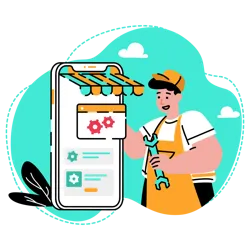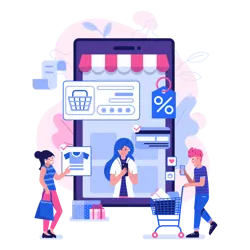You have an online business and customers ready to buy — now what? It’s time to set up eCommerce payment processing to accept payments from your customers. Each transaction involves the cooperation of a payment gateway and payment processor to gather information, verify funds, and transfer the money into your account.
Does this sound confusing? Don’t worry. This guide will define how the process works, detail the players involved, and give you actionable tips for selecting the best eCommerce payment processor.
Key Takeaways
- Online transactions rely on payment gateways and payment processors to move funds between your customers’ accounts and your business account.
- You can make eCommerce payment processing easier for customers and make more sales by streamlining the user interface and offering multiple payment options.
- When choosing a payment processor, consider fees and costs, security measures, and compatibility with your existing tech stack.
How Does eCommerce Payment Processing Work?

First, let’s take a quick look at how payment processing works. Below are the three essential steps involved every time a customer purchases your goods or services.
Step 1. Capturing Payment Information
Once at checkout, the customer inputs their payment information. This can be in the form of a credit card, Apple Pay or Google Wallet, a draft from their bank account, etc. The payment information entered is sent to and stored in the payment gateway connected to your store.
Step 2. Verifying Funds
The payment gateway then sends your customer’s payment information, encrypted and secured, as a package to the relevant bank. If the cardholder, card information, and available balance check out, the bank returns an authorization. The issuing bank then approves the transaction, and the payment gateway notifies you, the merchant.
Up to this point, the transaction has taken just a few seconds.
Step 3. Facilitating Money Transfer
Finally, the payment processor takes over to settle the payment between your customer’s bank and your business bank account (merchant account) [1]. Stripe “Payment settlement explained: How it works and how long it takes.” Accessed April 8th, 2025. Settlement times can vary depending on the type of payment method. ACH transactions usually settle the next business day after the batch is sent. Electronic funds transfers are usually settled within hours. Digital wallets settle within one to three business days.
While the payment is being settled, you, the merchant, will settle the payment.
The whole process, from start to finish, including payment settlement, takes just a few business days.
Types of Payment Methods
With eCommerce, there are many ways for a customer to pay. From credit and debit cards to buy now, pay later programs, it’s crucial to support your customers’ favorite payment methods. Your payment processor determines which kinds of payments you can accept. Let’s explore some of the most popular payment methods for purchasing online.

Credit Cards & Debit Cards
If you’re accepting payments online, there is pretty much no way to avoid accepting credit cards and debit cards. Almost everyone has at least one credit or debit card, and many have their card info saved in their browser, making checkout a breeze. Plus, many shoppers often prefer to use credit cards online due to their enhanced security. [2]First Bank. “Fraud Protection Best Practices: When to use a Credit Card vs. a Debit Card.” Accessed April 8th, 2025.

Digital Wallets
Shopping from your phone has given rise to the use of digital wallets, allowing shoppers to skip digging out a physical card to enter their payment information.
To provide customers with convenient payment options, make sure your website supports popular digital wallets like Apple Pay and Google Wallet. These systems are already built into most phones, and they make the checkout process incredibly simple without costing you or your business any more than the standard price to process a normal debit or credit card.

Buy-Now-Pay-Later Options
Buy-now-pay-later (BNPL) programs are also very popular. Platforms like PayPal, Klarna, and Afterpay give customers the option to make larger purchases while paying over time. Supporting one or more of these BNPL platforms on your eCommerce store can entice customers to add a few extra things to their shopping cart or encourage them to check out now rather than wait.

Other Payment Methods
The three payment methods listed above are the most common in the U.S. [3]Statista. “Most common online payments by type in the U.S. as of December 2024.” Accessed April 8th, 2025. But they are not the only methods available. Here are some other payment options to consider supporting:
- Direct debit
- Invoice/ACH
- Reward points
- Cryptocurrencies
- Gift cards/prepaid cards
- Mobile payments
- Cash on delivery (cod)
Which methods are worth supporting for your business will depend on your business type, geographical location, and customer expectations.
Key Components of eCommerce Payment Processing
There are several parties involved in processing payments over the Internet. You have the customer, yourself as the merchant, a payment gateway, your payment processor, and the issuing bank and acquiring bank.
Though this may seem complicated at first glance, most of this process happens in a matter of seconds. Let’s take a detailed look at the three key elements involved.

Payment Gateways
A payment gateway is exactly what it sounds like. Imagine it as a physical gate that gives you access between banks. This gateway allows transaction information to pass between banks securely and nearly instantly.
When your customer inputs their payment information on your site, the details go to the payment gateway, which then encrypts cardholder data and sends it to the payment processor. The payment processor sends the information through the card network to the customer’s issuing bank for approval. Whether the transaction is approved or denied, the payment processor communicates the decision to the payment gateway. The gateway then notifies the merchant and customer.

Payment Processors
A payment processor is a company you contract to facilitate payments securely. Essentially, they are an intermediary between your customer’s bank account and your business bank account.
Imagine physically withdrawing cash from one bank and then traveling to another bank to deposit it. This is exactly what a payment processor does, but everything is completed online.
Without a payment processor, you can’t access the money your customer has paid for your goods and services.

Merchant Accounts
A merchant account is similar to a holding bank account, which is arranged and managed by your payment processor. Funds are secured here for a short time until the movement concludes. You can think of it a bit like an armored truck transporting cash between two banks.
Merchant accounts come with set parameters on how you’re allowed to use funds (i.e., how many transactions you’re allowed to process each day/month). Each eCommerce merchant account also has a unique identification number, or MID, for facilitating transactions.
Optimizing the Checkout Experience
How you process and accept online payments is crucial to the customer’s experience. If it’s difficult to make a purchase from your online store, customers may not buy from you.
By keeping your checkout process streamlined, offering multiple payment options, and reducing cart abandonment, successfully making sales will be easier and might win you repeat customers.

Streamlined User Interface
How many steps does it take to complete a purchase on your website? If it takes too many steps or is hard to navigate, it may lose you customers. While you may be a bit limited in what you can and can’t do based on the eCommerce platform you are using, here are some tips for streamlining the checkout process.
- Consider a one-page checkout
- Reduce the number of checkout steps
- Create a prominent call to action/checkout button
- Illustrate the checkout process for the customer (i.e., progress bar)
- Limit the fields the customer has to fill in
- Let your customers check out as a guest
- Keep the checkout screen free of clutter
Ask yourself what you would like to see as a customer when checking out, and see if you can implement it.

Multiple Payment Options
Offering a variety of payment options makes it easy for customers to check out. The easier it is for customers to check out, the more likely they are to do so. This can result in more sales for you as the business owner.
Customers wanting to pay over time with BNPL payment options might not appreciate having credit and debit card payments as their sole option. Or, supporting only one type of digital wallet, like Apple Pay, could alienate Google Wallet users. The more payment methods you support, the less likely the customer is to abandon checkout.

Reducing Cart Abandonment
Seeing your customers get to that final checkout screen and then leave can be frustrating. More than 70% of online consumers abandon their cart at some point during the checkout process [4], Statista. “Online shopping cart abandonment rate worldwide between 2006 to 2025.” Accessed April 8th, 2025.
So, how do you convert an abandoned shopping cart into a completed sale? In addition to streamlining the checkout process and offering plenty of payment options, here are some other actions you can consider taking:
- Offer multiple shipping options
- Let customers check out without creating a user account
- Display security badges
- Be transparent in your pricing
- Have a solid returns policy or money-back guarantee
- Craft a mobile-friendly website
- Offer live chat support to help customers complete their purchase
- Address any website issues (bugs, downtime, etc.) immediately
After all, less cart abandonment equals more money in your pocket, so it pays to prevent this as much as possible.
Evaluating Payment Processors
You probably recognize by now that selecting the right eCommerce payment solution is crucial to the checkout experience. However, choosing the best payment processor requires a little research. You need to find a partner that:
- Keeps the processes simple
- Protects your business and customers
- Secures data
- Works with your website
- Offers convenient payment options
- Has solid customer support
- Is affordable
- Offers quick funding
Next, let’s dive into the details of exactly what to look for and how to compare different payment processors.

Understanding Fees and Costs
Of course, one of the most important aspects you’ll want to consider as a business owner is the overall cost and fees charged during eCommerce payment processing. For instance, while it’s beneficial to support as many types of payments as possible, processing certain payment methods comes with higher fees, resulting in a smaller margin for you.
There are also payment processor-specific fees like monthly/annual service fees, interchange fees, gateway fees, PCI compliance fees, chargeback fees, and more. It’s important to consider all the potential fees and evaluate how they impact your bottom line.

Assessing Security Measures
You want your customers to feel like purchasing from you online is safe. One of the standard ways of achieving fraud prevention is through payment card industry (PCI) compliance.
The PCI DSS Security Council sets the PCI standards for the financial services industry. They keep track of fraud trends and security vulnerabilities and respond with regulations to keep businesses that process payments and manage credit card data safe.
In order to accept these payments securely each year, both you and your payment processor need to certify PCI DSS compliance. This not only helps verify your compliance but can also limit your liability.
For additional payment data security, it’s good to have a payment processor that tokenizes card data. Tokenizing is the process of transforming raw and real data (full card numbers, expiration dates, addresses, etc.) into a token (i.e., replacing it with a code). This prevents bad actors from accessing valuable information during a transaction.

Checking Compatibility With Business Systems
The eCommerce platform you use may limit your payment processor options. If you already have a website set up with an online store ready to go, you need a payment processor that can work with your existing systems.
If, on the other hand, you have not yet built your website, you may have a wider pool of options to consider. Either way, ensure your chosen partner offers the features you’ll need both today and as you scale your business.
Staying Competitive in the Global Marketplace

Choosing the right payment processor can help keep your business competitive. Offering more payment options can improve your customers’ experience. Robust security and minimal processing fees can help you keep more profit in your pocket.
If you want a partner that offers a lightning-fast process, has an integrated payment gateway, utilizes top-notch security features, and supports many eCommerce platforms, contact PaymentCloud. Our application process is easy; there’s no setup fee, and we can complete the setup in just one day. Learn more about our eCommerce services now.







